Surfing: Riding the Wave of Adventure
For centuries, surfing has captivated the human spirit, transforming from an ancient Polynesian tradition to a global phenomenon. More than just a sport, it’s a connection with the ocean, a dance with nature’s energy, and a pathway to physical and mental well-being. Whether you’re a seasoned wave rider or just dreaming of catching your first break, understanding the fundamentals of surfing is the key to unlocking its endless possibilities. Let’s dive into the exhilarating world of surfing and explore everything you need to know to get started.
Understanding the Basics of Surfing
Surfing involves riding a wave towards the shore while standing on a surfboard. It requires a combination of physical fitness, balance, timing, and wave knowledge. Beyond the basics, understanding ocean conditions, board types, and surfing etiquette is crucial for a safe and enjoyable experience.
Wave Dynamics
Waves are formed by wind transferring energy to the water’s surface. Understanding wave dynamics is essential for surfers to predict and navigate the ocean effectively. Key aspects include:
- Wave Height: The vertical distance between the crest (highest point) and trough (lowest point) of a wave.
- Wave Period: The time it takes for two successive wave crests to pass a fixed point. A longer period generally indicates a more powerful wave.
- Wave Frequency: The number of waves passing a fixed point in a given time.
- Breaking Waves: Waves break when their height becomes unsustainable due to the decreasing depth of the ocean floor. Different types of breaks (e.g., beach breaks, point breaks, reef breaks) offer unique surfing experiences.
- Swell Direction: The direction from which the waves are approaching. This impacts which beaches will receive the best waves.
Surfboard Anatomy and Types
Choosing the right surfboard is crucial for your surfing journey. Surfboards vary in size, shape, and material, each suited to different skill levels and wave conditions. Key parts include:
- Nose: The front of the board.
- Tail: The back of the board.
- Deck: The top surface where you stand.
- Bottom: The underside of the board.
- Rails: The edges of the board.
- Fins: Located on the bottom of the board, providing stability and control.
Common surfboard types:
- Longboards: Ideal for beginners and smaller waves. They offer stability and easy paddling. Typically 8-12 feet long.
- Funboards: A versatile option, shorter than longboards but longer than shortboards, suitable for intermediate surfers. Typically 7-8 feet long.
- Shortboards: Designed for experienced surfers and performance surfing in larger waves. Offer maneuverability and speed. Typically 5-7 feet long.
- Fish Boards: Wider and shorter than shortboards, good for small to medium-sized waves.
- Guns: Large boards designed for surfing very big waves.
Essential Surfing Equipment
Beyond the surfboard, several pieces of equipment are essential for surfing:
- Wetsuit: Provides insulation in cold water. Wetsuit thickness varies based on water temperature.
- Leash: Connects the surfboard to your ankle, preventing it from drifting away after a wipeout.
- Surf Wax: Applied to the deck of the surfboard to provide traction.
- Rash Guard: Protects your skin from chafing and sun exposure.
- Sunscreen: Essential for protecting your skin from the sun’s harmful rays.
- Earplugs: Can help prevent surfer’s ear (exostosis) in cold water.
Mastering the Fundamentals: From Land to Sea
Before hitting the waves, practicing essential techniques on land can significantly improve your performance and confidence in the water.
Pop-Up Technique
The pop-up is the fundamental movement of going from lying down on the board to standing. Practice these steps on land:
- Tip: Practice this repeatedly on land until it becomes a fluid, natural motion. Aim for speed and accuracy.
Paddling Techniques
Efficient paddling is crucial for catching waves and positioning yourself in the lineup.
- Proper Positioning: Lie on the board with your chest centered, looking ahead.
- Paddle Stroke: Reach forward with alternating arms, keeping your elbows high and your hands cupped.
- Body Alignment: Maintain a streamlined body position to minimize drag.
- Looking for Waves: Scan the horizon for approaching waves while paddling.
- Example: When paddling for a wave, increase your paddling speed and power to match the wave’s speed.
Understanding Ocean Safety
Surfing comes with inherent risks. Understanding ocean safety is paramount for your well-being and the safety of others.
- Rip Currents: Powerful currents flowing away from the shore. If caught in a rip current, paddle parallel to the shore until you are out of the current, then paddle towards the shore.
- Wave Conditions: Assess the size, power, and consistency of the waves before entering the water.
- Marine Life: Be aware of potential hazards such as jellyfish, sharks, and sea urchins.
- Other Surfers: Maintain a safe distance from other surfers and be mindful of right-of-way rules.
- Tides: Understand how tides affect wave conditions and water depth.
Choosing the Right Surf Spot and Conditions
Selecting the right surf spot and understanding the conditions is essential for a positive surfing experience, especially for beginners.
Beginner-Friendly Surf Spots
Look for beaches with gentle, rolling waves, sandy bottoms, and minimal crowds.
- Example 1: Waikiki Beach, Hawaii – Known for its gentle waves and calm waters, ideal for learning.
- Example 2: San Onofre State Beach, California – Offers mellow waves suitable for longboarding and beginner surfing.
- Example 3: Kuta Beach, Bali – Popular with beginners due to its consistent, gentle waves.
Checking Surf Reports and Forecasts
Utilize surf forecasting websites and apps to gather information about wave height, period, wind direction, and tide.
- Popular Websites: Surfline, Magicseaweed, Windguru.
- Interpreting Data: Pay attention to swell size, swell direction, and wind conditions. Offshore winds (blowing from land to sea) typically create cleaner, more organized waves.
Understanding Tides and Their Impact
Tides can significantly affect wave quality and beach conditions.
- High Tide: Can soften waves and make them less powerful.
- Low Tide: Can make waves steeper and faster, and may expose shallow reefs or sandbars.
- Ideal Tide: The ideal tide varies depending on the surf spot. Some spots perform best at high tide, while others are better at low tide. Consult local surfers or surf shops for advice.
Surfing Etiquette and Respect for the Ocean
Surfing culture emphasizes respect for the ocean and fellow surfers. Adhering to surfing etiquette ensures a harmonious and safe experience for everyone.
The Right-of-Way Rule
The surfer closest to the peak of the wave has the right-of-way.
- Don’t Drop In: Dropping in occurs when a surfer paddles into a wave that another surfer is already riding. It’s considered a major breach of etiquette.
- Paddle Wide: When paddling back out to the lineup, paddle wide around the breaking waves to avoid interfering with surfers riding waves.
Respecting Localism
Local surfers often have a strong connection to their surf spots. Be respectful of their knowledge and experience.
- Show Respect: Acknowledge the presence of local surfers and avoid being overly aggressive or competitive.
- Follow Local Customs: Observe and respect local surfing customs and traditions.
Environmental Responsibility
Protecting the ocean environment is a shared responsibility among surfers.
- Leave No Trace: Pack out all trash and avoid littering on the beach or in the water.
- Use Reef-Safe Sunscreen: Choose sunscreens that are free of harmful chemicals that can damage coral reefs.
- Support Sustainable Practices: Support businesses and organizations that promote ocean conservation.
Conclusion
Surfing is a rewarding activity that offers physical exercise, mental relaxation, and a deep connection with nature. By understanding the basics, mastering the fundamentals, choosing the right surf spots, and adhering to surfing etiquette, you can embark on an exciting journey of wave riding. Remember to always prioritize safety, respect the ocean, and enjoy the thrill of gliding across the water. So grab your board, paddle out, and experience the magic of surfing for yourself!



